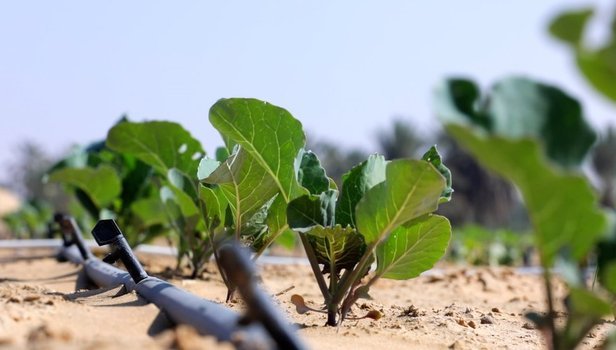Nano Clay Technology: Can it turn Desert into Fertile Farmland?
16 Dec 2020 ( IBTN News Bureau )
A major experiment was being completed in the United Arab Emirates in March 2020 when worldwide lockdown was underway. Within 40 days, a piece of barren land here was filled with sweet juicy watermelons.
For the United Arab Emirates, which imports 90 per cent of the need for fresh fruits and vegetables, this is an extraordinary achievement. With the addition of soil and water, the dry and hot desert of the United Arab Emirates turned into a field filled with lush fruits.
It was not so easy. These watermelons were possible only with the help of "nano clay" liquid. The story of this technique of reclaiming soil began 1,500 miles (2,400 kilometers) west of here two decades ago.
Yields began to decline in the 1980s in a part of the Nile Delta in Egypt. Despite being close to the desert, farming was done here for thousands of years.
It is because of its unmatched fertility that the ancient Egyptians used their energies to develop a powerful civilization, whose progress still makes the world astonished after thousands of years.
For centuries, the yields of farms that eradicate the hunger of the communities have declined within 10 years.
Why did yields fall?
Every year at the end of summer, the Nile River floods, which spreads into the Egyptian Delta.
When scientists began investigating the reduction of yields, it was found that the flood waters carried minerals, nutrients and raw clay particles from the basins of East Africa that spread throughout the delta region.
These fine particles of mud used to make the land there fertile. But then why did these particles disappear?
The Aswan Dam was built on the Nile River in southern Egypt in the 1960s. Two and a half miles (four kilometers) wide, this massive structure was built to create hydroelectricity and control floods to make farming easier to manage and crops are not wasted.
This dam inhibited the nutrients that came with the flood. Within a decade, delta yields declined. When soil scientists and engineers discovered the problem, a solution began to be found.
What is Nano Clay Technology?
"This is what you can see in your garden," says Ole Siewertsen, chief executive of Desert Control, a Norwegian company developing nano-clay technology.
"Sandy soil does not retain the moisture required for plants. By adding raw soil in the right proportion, this situation changes dramatically.''
In the words of Siewartsen, his plan is to move the barren desert land to "hope from the sand" using Nano clay.
Increasing yields by using mud is not a new thing. Farmers have been doing this for thousands of years. But working with heavy, thick soil has historically been very labor-intensive and may damage the underground ecosystem.
Tilling the plow, digging and turning the soil also cause damage to the environment. Organic elements buried in the soil are exposed to oxygen and are converted to carbon dioxide in the atmosphere.
Soil scientist Saran Sohi of Edinburgh University says that farming also disrupts the complex biome of the soil.
"An important part of soil biology is the symbiotic relationship between plants and fungi that serve as an extension of the root system of plants."
Root has life
Sohi says, "Fine structures even from the hair, called hyphae, are helpful in transporting nutrients to the roots of the plant."
In this process the fungi attach to the clay mineral particles. They maintain soil structure and limit erosion.
These structures are broken by digging or cultivating soil. It takes time to get them ready again. Till then, there is a possibility of damage to the soil and loss of nutrients.
If you mix very little solution of raw clay in sand, then it does not have any effect. If it is mixed too much, the soil may accumulate on the surface.
After years of testing, Fluid Dynamics engineer Kristian P. Olsen of Norway created a perfect mixture that, when mixed in sand, turns it into life-giving soil.
He says, "Not a single formula works everywhere. 10 years of testing in China, Egypt, UAE and Pakistan have taught us that every soil test is necessary, so that we can try the right nano clay recipe.''
Balance of soil solution
A large part of nano-clay research and development took place in creating a balanced liquid formula that could percolate into fine particles (nano particles) of the local soil, but would not flow so quickly that it would be lost completely. Its purpose is to show the effect of magic in the soil 10 to 20 cm below the root of the plants.
Fortunately, when it comes to sludge mixing in sand, a law of soil chemistry comes into play, called the Cationic Exchange Capacity of the soil.
"Sludge particles are negatively charged, while sand particles are positively charged," says Siewertsen. They join each other when they meet.''
A 200 to 300 nanometer thick layer of soil surrounds every particle of sand. This dispersed area of sand particles keeps water and nutrients from sticking to it.
"Raw soil acts like biological elements," says Siewartsen. It helps in retaining moisture. When these particles become stable and start providing nutrients, then you can sow the crop within seven hours.''
The technology has been developing for nearly 15 years, but has been in operation at the commercial level for the last 12 months, when Dubai's International Center for Bioseline Agriculture (ICBA) independently tested it.
Sivartsen says, "Now we have scientific evidence from its effectiveness. We want to build many mobile mini factories in 40 ft (13 m) containers so that we can bring as much change as possible.''
"These mobile units will manufacture liquid nano clo locally where needed. We will use the soil of the same country and employ people from the same region.''
The first such factory will produce 40 thousand liters of liquid nano clay in one hour, which will be used in City Parkland, UAE. This technology will save water up to 47 percent.
Cost reduction challenge
It currently costs around $ 2 (1.50 lb) per square meter, which is acceptable for small farms in the rich UAE.
But to make it effective in Sub-Saharan Africa, where it really matters, Sivertsen needs to reduce costs.
Most farmers in Africa do not have enough money to fix their land in this way. In this way the effect of the treatment of the ground lasts for about 5 years. After that the mud solution will have to be re-poured.
Sivertsen feels that large-scale work will reduce costs. Their goal is to bring the cost to $ 0.20 (0.15 lb) per square meter of land.
If you buy fertile land instead, it costs from $ 0.50 to $ 3.50 (0.38 pound to 2.65 pound) per square meter. In the future, it will be cheaper to make barren land fertile in this way than to buy a farm.
Siewartsen is also helping with the Great Green Wall Project. For this, he is working with the UN Convention to Combat Desertification. Walls of trees are being erected to prevent the spread of desert in North Africa.
Other ways to increase yield
Raw clay solution will be mixed in the sandy land of North Africa and Middle East, but what will we do in the rest of the world?
Globally, organic matter in the soil has decreased by 20 to 60 percent. Nano clay is suitable only for making sandy soil fertile.
What will you do if you have saline, non-sandy soil? Biochar can help you here.
This permanent form of carbon is prepared by burning organic materials with pyrolysis method. In this process, pollutants such as carbon dioxide are released very little because oxygen is kept out of the combustion process.
This creates a porous and light charcoal-like substance. Sohi says this is what a soil without nutrients needs.
She says, "The organic content of soil always changes, but a healthy soil has a certain level of permanent carbon."
"Biochars are permanent carbons that help to hold the nutrients important for plant growth." It takes decades for permanent carbon elements to develop in the soil, but biochar makes it happen immediately.''
"Biochar, along with other organic matter such as organic manure, can fix soil structure that leads to plant growth."
This can help restore soil that is depleted of organic matter due to over-farming or mining or contamination, provided that the poisonous elements present in the soil are remedied.
Other soil improvement techniques include the use of vermiculite. It is a phyllosilicate mineral which is extracted from rocks. It spreads by heating.
Being a sponge, it can absorb three times more water than its weight and can maintain it for a long time.
Putting it near the root of the plants keeps the moisture there, but it requires digging the soil, which is its downside.
Nutritional testing
In the United Arab Emirates, local community people are reaping the benefits of converting the desert into fertile land.
Vegetables and fruits grown using Nano Clay proved to be of great use in the Covid-19 lockdown. About 200 kg of watermelon, zucchini and bajra crops were grown in 0.2 acres (1,000 sq m) of land, which is enough for a house.
"The lockdown in the United Arab Emirates was very stringent in which imports had declined," says Siewertsen. Many people were unable to get fresh fruits and vegetables.''
"We worked with the ICBA and Red Crescent team to prepare fresh watermelons and zucchini."
Sivertsen also wants to test nutrients in crops prepared in this way, but will have to wait until the next crop.
(Click here for Android APP of IBTN. You can follow us on facebook and Twitter)
Share This News
About sharing
-
 04 Oct 2023
Nobel Prize in Chemistry awarded to three scientists for developing quantum dots
04 Oct 2023
Nobel Prize in Chemistry awarded to three scientists for developing quantum dots
Three scientists have been awarded the Nobel Prize in Chemistry for developing quantum dots...
-
 03 Oct 2023
Three scientists received the Nobel Prize for Physics
03 Oct 2023
Three scientists received the Nobel Prize for Physics
The Nobel Prize in Physics for the year 2023 has been awarded to scientists who conducted &...
-
 19 Feb 2021
Perseverance rover landed on Mars: will discover life on Mars
19 Feb 2021
Perseverance rover landed on Mars: will discover life on Mars
US space agency NASA's spacecraft Perseverance has landed on the surface of Mars.
... -
 21 Dec 2020
Jupiter and Saturn met after four hundred years
21 Dec 2020
Jupiter and Saturn met after four hundred years
Four hundred years later, Jupiter and Saturn, two planets in the solar system, came so clos...
-
 17 Dec 2020
China's big success in space: Chang E-5 vehicle returned after taking samples of the moon
17 Dec 2020
China's big success in space: Chang E-5 vehicle returned after taking samples of the moon
China's Chang E-5 vehicle has returned to Earth by taking samples of stone and soil fro...



